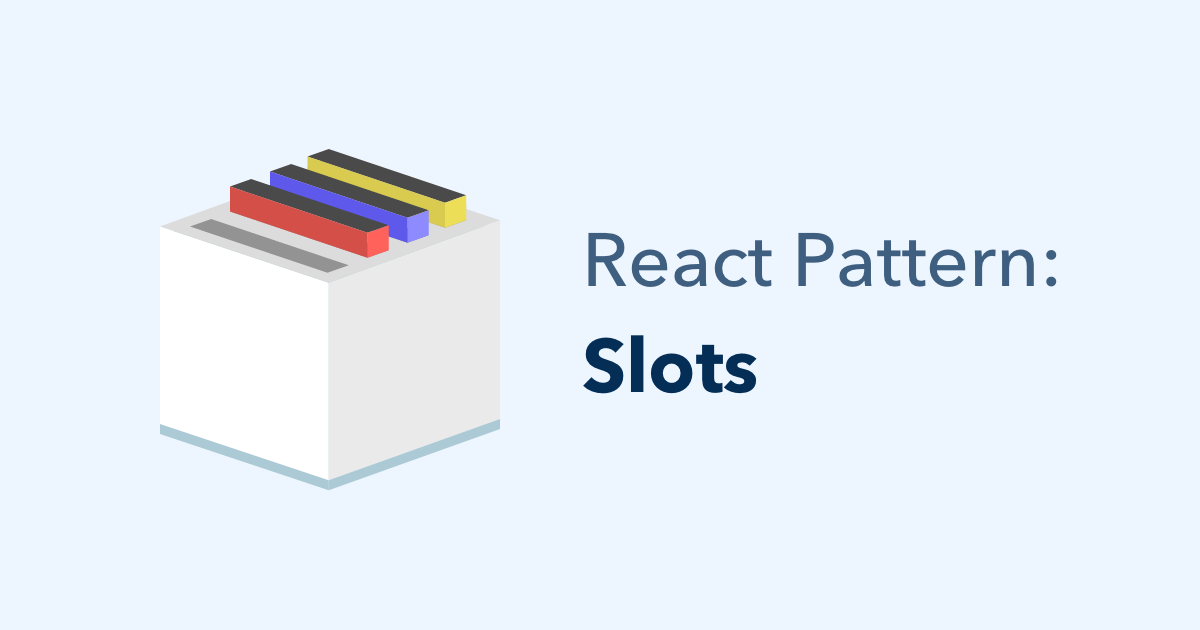
You need to create a reusable component. But the children prop won’t cut it. This component needs to be able to accept multiple children and place them in the layout as it sees fit – not right next to each other.
Maybe you’re creating a Layout with a header, a sidebar, and a content area. Maybe you’re writing a NavBar with a left side and a right side that need to be dynamic.
These cases are all easy to accomplish with the “slots” pattern – a.k.a. passing JSX into a prop.
TL;DR: You can pass JSX into any prop, not only the one named children, and not only by nesting JSX inside a component’s tag – and it can simplify data passing and make components more reusable.
Quick Review of React Children
So that we’re all on the same page: React allows you to pass children to a component by nesting them inside its JSX tag. These elements (zero, one, or more) are made available inside that component as a prop called children. React’s children prop is similar to Angular’s transclusion or Vue’s <slot>s.
Here’s an example of passing children to a Button component:
<Button>
<Icon name="dollars"/>
<span>BUY NOW</span>
</Button>Let’s zoom in on the implementation of Button and see what it does with the children:
function Button(props) {
return (
<button>
{props.children}
</button>
);
}The Button effectively just wraps the stuff you pass in with a button element. Nothing groundbreaking here, but it’s a useful ability to have. It gives the receiving component the ability to put the children anywhere in the layout, or wrap them in a className for styling. The rendered HTML output might look something like this:
<button>
<i class="fa fa-dollars"></i>
<span>BUY NOW</span>
</button>(This, by the way, assumes that the Icon component rendered out the <i> tag there).
Children is a Normal Prop Too
Here’s a cool thing about the way React handles children: the nested elements get assigned to the children prop, but it’s not a magical special prop. You can assign it just like any other. Behold:
// This code...
<Button children={<span>Click Me</span>} />
// Is equivalent to this code...
<Button>
<span>Click Me</span>
</Button>So not only can you pass children as a regular prop, but you can pass JSX into a prop? WHAT.
Yep. And this ability isn’t only for the prop named “children”…
Use Props as Named Slots
What if I told you, you can pass JSX into any prop?
(You already figured that out, didn’t you.)
Here’s an example of these “slots” props at work – invoking a component named Layout with 3 props:
<Layout
left={<Sidebar/>}
top={<NavBar/>}
center={<Content/>}
/>Inside the Layout component, it can do whatever it needs with the left, top and center props. Here’s a simple example:
function Layout(props) {
return (
<div className="layout">
<div className="top">{props.top}</div>
<div className="left">{props.left}</div>
<div className="center">{props.center}</div>
</div>
);
}You could imagine that Layout could be much more complex internally, with lots of nested divs or Bootstrap classes for styling or whatever. Or it could pass the sections down to specialized components. Whatever Layout needs to do, its user only needs to worry about passing in those 3 props left, top, and center.
Use Children to Pass Props Directly
Another nice thing about passing children as a prop (whether that’s children proper, or some other prop) is this: at the point where you pass in the child prop, you’re in the parent’s scope, so you can pass down whatever you need.
It’s like skipping a level. For instance: instead of having to pass, say, a “user” to a Layout and have the Layout pass the “user” to the NavBar, you can create a NavBar (with the user already set) and pass the whole thing into Layout.
This can help avoid the “prop drilling” problem where you’ve gotta thread a prop down through multiple layers.
function App({ user }) {
return (
<div className="app">
<Nav>
<UserAvatar user={user} size="small" />
</Nav>
<Body
sidebar={<UserStats user={user} />}
content={<Content />}
/>
</div>
);
}
// Accept children and render it/them
const Nav = ({ children }) => (
<div className="nav">
{children}
</div>
);
// Body needs a sidebar and content, but written this way,
// they can be ANYTHING
const Body = ({ sidebar, content }) => (
<div className="body">
<Sidebar>{sidebar}</Sidebar>
{content}
</div>
);
const Sidebar = ({ children }) => (
<div className="sidebar">
{children}
</div>
);
const Content = () => (
<div className="content">main content here</div>
);Now compare that to this solution, where the Nav and Body accept a user prop and are then responsible for manually passing it down to their children, and those children must pass it down to their children…
function App({ user }) {
return (
<div className="app">
<Nav user={user} />
<Body user={user} />
</div>
);
}
const Content = () => <div className="content">main content here</div>;
const Sidebar = ({ user }) => (
<div className="sidebar">
<UserStats user={user} />
</div>
);
const Body = ({ user }) => (
<div className="body">
<Sidebar user={user} />
<Content user={user} />
</div>
);
const Nav = ({ user }) => (
<div className="nav">
<UserAvatar user={user} size="small" />
</div>
);Not as nice, right? Threading props down this way (aka “prop drilling”) couples the components together more than you might want – not always a bad thing, but good to be conscious of. Using children as in the previous example can avoid having to reach for more complex solutions like context, Redux, or MobX (to name just a few).
Be Mindful of PureComponent / shouldComponentUpdate
If you need to implement shouldComponentUpdate (or PureComponent) on a component that takes children, and it prevents a re-render, that’ll prevent the children from rendering, too. So, just keep that in mind. In practice, components that have “slots” are probably pretty likely to be minimal and quick to render, anyway, and therefore less likely to need performance optimizations.
If you run into a situation where you do need to optimize performance of a “slotted” component, consider extracting the slow-performing part into a separate component, and optimizing it independently.
Learning React can be a struggle — so many libraries and tools!
My advice? Ignore all of them :)
For a step-by-step approach, check out my Pure React workshop.

Learn to think in React
- 90+ screencast lessons
- Full transcripts and closed captions
- All the code from the lessons
- Developer interviews
Dave Ceddia’s Pure React is a work of enormous clarity and depth. Hats off. I'm a React trainer in London and would thoroughly recommend this to all front end devs wanting to upskill or consolidate.
